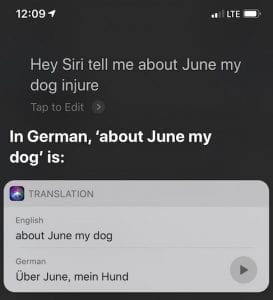I accidentally started Siri on my iPhone. It mistakenly thought I said, “Tell me about June my dog injure.” As you can see from the screenshot below, Siri was clueless about how to respond. It did make an effort, however.

Siri misunderstood the query, which led to a meaningless answer.
If you have shopped online using Alexa or Google Assistant, you may have encountered a similar experience.
According to “Adobe Digital Insights 2018,” more than 40 percent of consumers own a smart speaker, and that was before Q4 2018 sales. One would think we would all be shopping via voice.
But, that is not the reality. We are nearly as far away from conversational commerce now as three years ago. The primary use for voice commerce is to initiate a search for basic research. According to the same Adobe study, 30 percent of smart speaker owners use them to shop online, but only a small percentage consummate a purchase, even re-order.
The rise of voice search has been noteworthy. According to a 2018 study from Invoca, a voice analytics platform, titled “The Rise of Voice,” Google estimates that 20 percent of searches were initiated by voice in 2018. Google projects the percentage to be 50 percent by 2020. Consumers are becoming comfortable with initiating a voice search for weather, sports results, news, and so forth. Many people now dictate their text and email messages using voice on their smartphone.
Complicated Shopping
Shopping is too complicated to conduct by voice, at least thus far. There are too many products, variables, and attributes to choose from in most categories. The second challenge is dialog. Shoppers want to ask questions — engage in a conversation — but artificial-intelligence-powered voice assistants are not ready for that, yet. A third challenge for voice shopping is visual. Without photos or videos, it is difficult for people to visualize products.
I recently asked my Google Assistant for options to buy a 72-inch high-definition television. The assistant immediately listed five models and provided the brand name along with details about each one. I barely remembered any of the brands, much less any of the information, before it finished. The presentation was fast and one-way. It would have been difficult to go to the next step of specifications, pricing, user reviews, and so forth. This experience would be much better if I had Google Home Hub and a screen for viewing product information.
The results from voice shopping are likely to be poor for the foreseeable future. There are, again, too many variables to select for a typical product. Even for a simple t-shirt, there are many attributes — such as size, gender, color, style, fabric, price, and brand. Artificial intelligence is improving, but, still, the voice shopping process should include a concise path to help a shopper sort through the various choices.
An Opportunity
Does this mean voice shopping is a low priority? Absolutely not. It’s an opportunity that manufacturers and retailers should be investing in right now for certain types of products.
The opportunity is to go beyond the voice search that returns a single level of detail to a more informative, guided conversation. What is needed is a virtual shopping assistant that can walk a buyer through an entire purchase journey.
Items such as an HDTV, an espresso machine, a bike, and furniture are ideal candidates for a virtual assistant. A native app on a smartphone is currently the best platform to deliver that experience. It could be combined with augmented reality and buyer preferences to improve the experience.
Essentially, the app would work much like a sales associate in a physical store, by guiding buyers through a series of questions to match products to their needs. With an app, product content and other specs could be presented visually in addition to spoken words.
Nellie the Assistant
Here’s an example. Assume I am using the iPhone app of an electronics retailer as I shop for a new television.
I named my virtual assistant Nellie after my grandmother for no particular reason other than there are not many Nellies today. I gave her a snappy Australian accent because I like the sound of it.
Dale: Hello Nellie. I would like to buy a new TV.
Nellie: Hi Dale. Would you like me to help you select a new HDTV?
Dale: Yup.
Nellie: What size are you looking for? 55”, 60”, 72” or larger?
Dale: 72” or larger.
Nellie: Do you have a preference between HDTV, 4K Ultra, or OLED?
Dale: OLED, please
Nellie: I see selections from Sony, Samsung, and Visio. Do you have a brand preference?
Dale: Not really.
Nellie: Do you have a sound system, such as a sound bar or a 5.1 or 7.2 receiver?
Dale: I have a 5.1 receiver.
Nellie: Prices range from $1,200 to $3,000 for 72-inch OLED TV from Sony, Visio, and Samsung that meets your other requirements. Should I prepare a comparison and recommendation?
Dale: Yes, please.
Nellie: I will prepare the comparison for you now.
Next, Nellie could assemble a neatly arranged comparison table including user and expert reviews for each of the TVs. Additional steps could include online chat and in-store demos.
New Platforms
Is this far fetched? No. It could be developed today using a combination of commercial platforms, native application toolsets, and voice devices. The benefit of the app is the ability to present visual content and product information in a single environment that also supports voice.
The early stages of these capabilities are in development now. There are new voice platforms on the market that help manage voice content and the script to guide a user through a purchase journey. The platforms are also device agnostic — they work on all voice products.
Voicify and Cognigy are examples of new providers. Both work with commerce platforms and search vendors to allow companies to more easily deploy voice results for content, customer service, and sales processes. Buyers still want to see products. Thus presenting images and specifications on a screen is critical. It means integrating with a native app on a smartphone or using a digital assistant with a screen, such as Echo Spot, Echo Show, or Google Home Hub.





